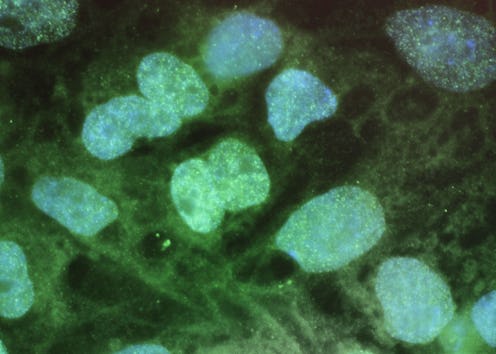News
How Human Fat Cells Could Save Lives
In what sounds like a plot point straight out of House, fat may be used to regenerate hearts and save lives. Yes — the adipose tissue (fat cells) you've been warned against for years may, in fact, be the medical miracle for which we've been searching. Stem cells from fat have shown the ability to differentiate into muscle, bone, fat, cardiac, neuronal and liver cells, which means that they could be used to treat a plethora of conditions and be utilized in several different regions of the body — from the brain to the heart to the liver.
The health perils associated with being overweight have been broadcast for as long as we can remember: In 2008, Wake Forest University released a study that suggested that excess fat around the heart may increase the risk of heart attacks, and other studies have yielded similar results. But researchers Jalees Rehman and Keith March may be turning the world on its head with their new research.
Where did this all begin? Well, in 2001, a team from UCLA first discovered that there were stem cells in liposuction fat. Stem cells are that have not yet specialized to function in a specific part of the body, and therefore have the capacity to grow into a variety of different roles. This makes stem cells incredibly important, as they can serve a multiplicity of purposes. Unfortunately, the best and most differentiable stem cells historically come from embryos, raising considerable controversy around the ethics of collecting stem cells.
However, in the past couple of years, fat stores have been shown to serve as excellent holding grounds for particularly resilient stem cells, ones that are able to survive in harsh conditions including oxygen and nutrient deprivation. In fact, going a step beyond surviving, stem cells from fat actually seem to thrive in these stressful conditions, and may even be activated by stress. These stem cells were discovered by accident in 2013 when scientists were further studying the ability of liposuction fat to grow different types of cells. When a piece of lab equipment failed, however, all cells died off except for these stem cells.
A major advantage of stem cells derived from liposuctioned fat is the amount of stem cells yielded. There are generally five criteria that stem cells used for regenerative medicine should meet. Included in this list is the ability to be "found in abundant qualities (million to billions of cells) as well as the ability to be "harvested by a minimally invasive procedure." Adult stem cells can also be found in bone marrow, but this process meets neither of the aforementioned criteria, as the incredibly painful procedure generally results in only 5,000 to 60,000 cells. Liposuction, on the other hand, is a relatively easy 20-minute procedure that delivers 40 million cells.
In recent clinical trials, doctors have experimented with using these stem cells to treat chronic back pain caused by damaged spinal discs, a condition that affects approximately one in four Americans. The discs serve as cushions for the spine, allowing for flexibility but also absorbing the shock associated with movement. However, as we age, our discs age as well, and their exterior becomes harder and more prone to cracking, and the gel-like interior begins to lose water content. This means less protection for the spine and more pain in the back, arms, or legs. But when scientists injected stem cells from fat into these discs in mice, they found that the height of the discs increased by 26 percent, alleviating their compression.
Additionally, the water content of discs' interior also increased, which provides additional cushioning for the spine. The treatment is now being applied to 100 human patients in three clinics across the United States, and scientists are optimistic about the results. Jane Tadman, from Arthritis Research UK, believes that these "stem cells offer a promising source...with which to treat degenerative disc disease."
And it is not just back tissue and discs that can be aided by fat stem cells: Researchers Jalees Rehman and Keith March have found that these stem cells have the capacity to mimic blood vessels. In fact, they found that several factors present in these cells allow for the survival, regeneration and growth of blood vessels. And because these cells' growth and function are triggered by harsh conditions, they did not grow indiscriminately, but rather developed when oxygen levels were low, which makes them a "very attractive option for treating cardiovascular disease."
When these cells were tested on mice who had blood supply to their lower bodies cut off, scientists found that mice who had cells injected into their legs regenerated blood vessels and improved blood flow more than those that did not.
While stem cells from fat still need to be further tested for their usefulness and their safety, this comes as a major medical breakthrough in utilizing a resource that we're sometimes all too eager to rid ourselves of. This doesn't mean that we should be gaining weight in order to save our lives later on, but certainly offers a new dimension to medical possibilities.
